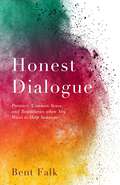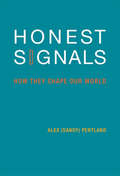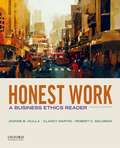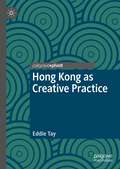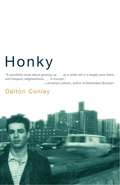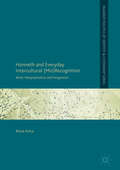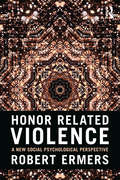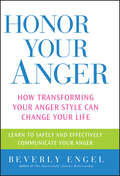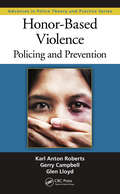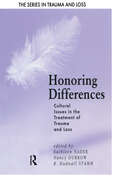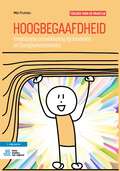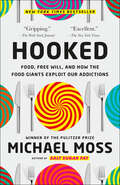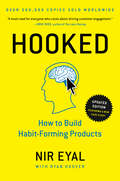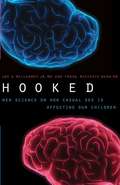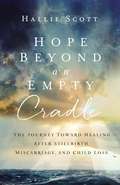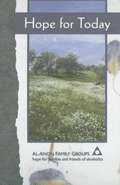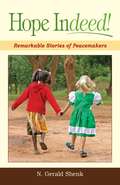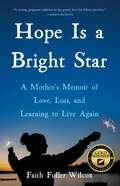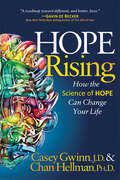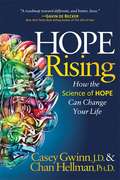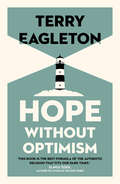- Table View
- List View
Honest Dialogue: Presence, Common Sense, and Boundaries when You Want to Help Someone
by Bent FalkFocusing on how someone in need can best be helped, the author identifies the skills and honesty of the person who wants to help as key to how effective this can be. Looking in detail at the nature of boundaries, willingness to speak from a place of authenticity and to be honestly present to the experience of the individual person, and the sensitive and economical use of language, the author shows how people in a state of deep personal crisis can be richly helped. Taking the view that no set response is always right or always wrong, he argues strongly for the importance of going with what is spontaneous and real in the moment, and responding thoughtfully and with integrity to the experience of the person in need. The book is an inspiration to develop deep awareness about the practice of encounter. Focusing on experiences of crisis and anxiety, the author provides many in-depth case examples, and sample scripts with actual questions and answers included. This short and deceptively simple book will raise awareness of, and broaden the range of, possible interventions for the open-minded reader.
Honest Signals
by Alex Sandy PentlandHow can you know when someone is bluffing? Paying attention? Genuinely interested? The answer, writes Sandy Pentland in Honest Signals,is that subtle patterns in how we interact with other people reveal our attitudes toward them. These unconscious social signals are not just a back channel or a complement to our conscious language; they form a separate communication network. Biologically based "honest signaling," evolved from ancient primate signaling mechanisms, offers an unmatched window into our intentions, goals, and values. If we understand this ancient channel of communication, Pentland claims, we can accurately predict the outcomes of situations ranging from job interviews to first dates. Pentland, an MIT professor, has used a specially designed digital sensor worn like an ID badge--a "sociometer"--to monitor and analyze the back-and-forth patterns of signaling among groups of people. He and his researchers found that this second channel of communication, revolving not around words but around social relations, profoundly influences major decisions in our lives--even though we are largely unaware of it. Pentland presents the scientific background necessary for understanding this form of communication, applies it to examples of group behavior in real organizations, and shows how by "reading" our social networks we can become more successful at pitching an idea, getting a job, or closing a deal. Using this "network intelligence" theory of social signaling, Pentland describes how we can harness the intelligence of our social network to become better managers, workers, and communicators.
Honest Signals: How They Shape Our World (The\mit Press Ser.)
by Alex PentlandHow understanding the signaling within social networks can change the way we make decisions, work with others, and manage organizations.How can you know when someone is bluffing? Paying attention? Genuinely interested? The answer, writes Alex Pentland in Honest Signals, is that subtle patterns in how we interact with other people reveal our attitudes toward them. These unconscious social signals are not just a back channel or a complement to our conscious language; they form a separate communication network. Biologically based “honest signaling,” evolved from ancient primate signaling mechanisms, offers an unmatched window into our intentions, goals, and values. If we understand this ancient channel of communication, Pentland claims, we can accurately predict the outcomes of situations ranging from job interviews to first dates.Pentland, an MIT professor, has used a specially designed digital sensor worn like an ID badge—a “sociometer”—to monitor and analyze the back-and-forth patterns of signaling among groups of people. He and his researchers found that this second channel of communication, revolving not around words but around social relations, profoundly influences major decisions in our lives—even though we are largely unaware of it. Pentland presents the scientific background necessary for understanding this form of communication, applies it to examples of group behavior in real organizations, and shows how by “reading” our social networks we can become more successful at pitching an idea, getting a job, or closing a deal. Using this “network intelligence” theory of social signaling, Pentland describes how we can harness the intelligence of our social network to become better managers, workers, and communicators.
Honest Work: A Business Ethics Reader
by Clancy Martin Joanne B. Ciulla Robert C. SolomonIn today's business world, ethics is not simply a peripheral concern of executive boards or a set of supposed constraints on free enterprise. Ethics stands at the very core of our working lives and of society as a whole, defining the public image of the business community and the ways in which individual companies and people behave. What people do at work--and how they think about work--determines their attitudes and aspirations, affecting and even structuring their personal lives and habits. <P><P>Working from this premise, Honest Work: A Business Ethics Reader provides a practical overview of business ethics that concentrates on the ethical problems and dilemmas students are most likely to face in their prospective work environments. Classic and recent articles and cases cover a broad spectrum of issues and concerns--from private ethical dilemmas to larger considerations of corporate values--and propose guidelines for thinking about the business world in a moral context. Each reading and case is followed by lively questions for discussion. <P><P>Offering a welcome alternative to the impersonal tone of most business ethics texts, the editors address students in an appealing and conversational manner. They provide engaging chapter introductions that include personal narratives and also present the ideas of great philosophers in a unique way--as emails. <P><P>Ideal for introductory undergraduate and MBA courses in business ethics, Honest Work: A Business Ethics Reader can be read as a coherent narrative but also offers instructors great flexibility, as its various chapters, readings, and cases can be pursued in almost any order. A Companion Website featuring chapter objectives and summaries, study questions, self-tests, and off-site links of interest will soon be available. An Instructor's Manual with Test Bank is available to adopters.
Hong Kong as Creative Practice (Palgrave Studies in Creativity and Culture)
by Eddie TayIn this book, Hong Kong is seen as a labyrinth, a postmodern site of capitalist desires, and a panoptic space both homely and unhomely. The author maps out various specific locations of the city through the intertwined disciplines of street photography, autoethnography and psychogeography. By meandering through the urban landscape and taking street photographs, this form of practice is open to the various metaphors, atmospheres and visual discourses offered up by the street scenes. The result is a practice-led research project informed by both documentary and creative writing that seeks to articulate thinking via the process of art-making. As a research project on the affective mapping of places in the city, the book examines what Hong Kong is, as thought and felt by the person on the street. It explores the everyday experiences afforded by the city through the figure of the flâneur wandering in shopping districts and street markets. Through his own street photographs and drawing from the writings of Byung-Chul Han, Walter Benjamin and Michel de Certeau, the author explores feelings, affects, and states of mind as he explores the city and its social life.
Honky
by Dalton ConleyThe author recalls how his childhood had all of the classic elements of growing up in America. His entertaining memoir as child, teenager and adult reveals how race and class impact all of us.
Honneth and Everyday Intercultural: Work, Marginalisation And Integration (Palgrave Politics Of Identity And Citizenship)
by Bona AnnaThis book conducts a critical investigation into everyday intercultural recognition and misrecognition in the domain of paid work, utilising social philosopher Axel Honneth’s recognition theory as its theoretical foundation. In so doing, it also reveals the sophistication and productivity of Honneth's recognition model for multiculturalism scholarship.Honneth and Everyday Intercultural (Mis)Recognition is concerned with the redress of intercultural related injustice and, more widely, the effective integration of ethically and culturally diverse societies. Bona Anna analyses the everyday experiences of cross-cultural misrecognition in a distinctive ethno-cultural group, including social norms that have been marginalised in the contexts of employment. In this endeavour, she deploys key constructs from Honneth’s theory to argue for individual and social integration to be conceptualised as a process of inclusion through stables forms of recognition, rather than as a process of inclusion through forms of group representation and participation. This book will appeal to students and academics of multiculturalism interested in learning more about the usefulness of Honneth’s recognition theory in intercultural inquiry, including the ways in which it can circumvent some of the impasses of classical multiculturalism.
Honor Related Violence: A New Social Psychological Perspective
by Robert ErmersHonor related violence is generally associated with crimes committed by people from the Middle East and adjacent areas. Perpetrators sometimes justify their deeds saying they ‘had to’ restore their honor. Theorists have argued that men from these populations exclusively correlate honor with the behaviour of their womenfolk, which they use as a pretext to further oppress and dominate women. Due to large-scale migration, western societies have become acquainted with honor related violence and honor killings. In this book, Robert Ermers addresses a number of questions related to honor related violence, including the use of predominantly negative frames regarding the cultural and social background of non-westerners and immigrants. In many publications, including the press, crimes committed by non-western individuals are often attributed to their cultural background rather than specific contexts or circumstances, in contrast to western cases. Vague and insufficiently defined concepts such as ‘honor’ and ‘culture’ strongly contribute to this bias. Honor Related Violence deals with honor and honor related violence, their background and contexts, what honor is, and what it is not. It examines stigma in relation to honor and based upon stigma research, reliably explains, analyses, and predicts honor related violence. The book argues that people all over the world can be stigmatized, excluded and ostracized when they commit misbehavior, and therefore find themselves in a state of dishonor which can lead to honor related violence. A timely intervention into the psychology of honor related violence, this is an essential resource for students and researchers in the fields of social psychology, sociology, law, criminology and anthropology.
Honor Your Anger: How Transforming Your Anger Style Can Change Your Life
by Beverly EngelFrom a leading expert, a guide to changing your anger style and successfully communicating your feelings. Do you act out your anger in destructive or underhanded ways? Or do you suppress your anger and turn other people&’s abuse and criticism against yourself? Anger is a normal, healthy emotion. But if it&’s channeled in negative directions, anger can do real damage to you and your loved ones. In this provocative, healing book, psychotherapist Beverly Engel explains why your personal anger style may be hurting your relationships, your career, and yourself. She then shows you step by step how to transform a negative anger style into a positive one. Once you've discovered how to express your anger in healthy ways, you'll find that anger can empower you, motivate you to make important changes, and help you gain a sense of control over your life. &“You can indeed learn to understand and manage your anger, and this book will show you how.&” —Robert Epstein, Ph.D., West Coast Editor, Psychology Today, Director Emeritus, Cambridge Center for Behavioral Studies, University Research Professor, California School of Professional Psychology &“A critical first step for people who have trouble getting in touch with their anger and expressing it in direct and appropriate ways.&” —Virginia Williams, Ph.D., coauthor of Anger Kills and Lifeskills
Honor, Symbols, and War
by Barry O'NeillNelson Mandela's presidential inauguration invitation to his former jailer; the construction and destruction of the Berlin Wall; the Gulf War's yellow ribbons. While the symbolic nuances of words and actions such as these are regular concerns for foreign policy practitioners, the subject has never been emphasized in international relations theory. That will change with the publication of this exceptionally original work. Many practitioners see symbolism as peripheral compared to resources, interests, military power, and alliances. Those who theorize about norms, ideas, and institutions tend to be open to the importance of symbolism, but they have not drawn out its details. Barry O'Neill's Honor, Symbols, and War puts symbolism at the center of the discussion. O'Neill uses the mathematical theory of games to study a network of concepts important in international negotiation and conflict resolution: symbolism, honor, face, prestige, insults, and apologies. His analysis clarifies the symbolic dynamics of several phenomena, including leadership, prenegotiation maneuvers, crisis tension, and arms-control agreements. This book will be of interest to political scientists, in particular those involved with game theory and international relations. Its findings also will prove useful to students of cultural anthropology, sociology, social psychology, and political behavior. Barry O'Neill is Associate Professor of Politics, School of Management, Yale University.
Honor-Based Violence: Policing and Prevention (Advances in Police Theory and Practice)
by Karl Anton Roberts Gerry Campbell Glen LloydHonor-based violence (HBV) is a crime committed to protect or defend the honor of a family and/or a community. It is usually triggered by the victim‘s behavior, which the family and/or community regards as causing offense or dishonor. HBV has existed for thousands of years but has only very recently become a focus of law enforcement, policy makers,
Honoring Differences: Cultural Issues in the Treatment of Trauma and Loss (Series in Trauma and Loss)
by Kathleen Nader Nancy Dubrow B. Hudnall StammWars, violence, and natural disasters often require mental health interventions with people from a multitude of ethnic groups, religions, and nationalities. Within the United States, those who care for the victims of trauma often assist individuals from a variety of immigrant cultures. Moreover, many aspiring mental health professionals from other countries seek training in the United States, creating an additional need for a broad cultural awareness within educational institutions.Honoring Differences deals with the treatment of trauma and loss while recognizing and understanding the cultural context in which the mental health professional provides assistance. Training in the cultural beliefs that may interact with traumatic reactions is essential, both to assess traumatic response accurately and to prevent harm in the process of assessing and treating trauma. Various cultures within the United States and several international communities are featured in the book.Each culturally-specific chapter aims to help the caregiver honor the valued traditions, main qualities, and held beliefs of the culture described and prepare to enter the community well-informed and well-equipped to intervene or consult effectively. Further more, the book provides information about issues, traditions, and characteristics of the culture, which are essential in moving through the phases of post-trauma or other mental health intervention.Mental health professionals, trauma specialists, missionaries, and organizations that send consultants to other nations, will find Honoring Differences essential reading. It will also be a resource to those who are interested in cultural differences and in honoring the belief systems of other cultures and nations.
Hoogbegaafdheid (jong)volwassenen: Toolbox voor de praktijk
by Mia FrumauDit boek geeft aankomende en ervaren professionals in de jeugd-GGZ nieuwe inzichten en praktische handvatten voor hun werk met hoogbegaafde cliënten. Hoogbegaafdheid: Emotionele ontwikkeling bij kinderen en (jong) volwassenen. Toolbox voor de praktijk gaat uit van een holistisch mensbeeld. Niet het label hoogbegaafdheid staat centraal, maar de emotionele ontwikkeling van kinderen en (jong)volwassenen met een hoog ontwikkelingspotentieel. Een risicofactor in hun psychosociale ontwikkeling is het ervaren van een mismatch met hun omgeving. Het boek geeft handvatten om juist het omgekeerde te bereiken. Dit heet ‘Goodness of Fit’. Het boek legt daarvoor het accent op de samenwerking tussen thuis, onderwijs en zorg. Hoogbegaafdheid: Emotionele ontwikkeling bij kinderen en (jong) volwassenen. Toolbox voor de praktijk gaat in op verschillende vragen. Bijvoorbeeld wat we verstaan onder hoog ontwikkelingspotentieel. Hoe we krachten, ontwikkelpunten en ontwikkelingsdomeinen in beeld krijgen. Wat maakt dat een “t”-trauma of een sociaal wenselijk masker, een Persona, ontstaat. Het laatste hoofdstuk geeft aanbevelingen voor de praktijk. Het boek wisselt theorie af met concrete praktijkvoorbeelden. Ook zijn er handige werkbladen. Deze werkbladen komen uit de Goodness-of-Fit Dialoog Toolbox, waarbij ook een kaarttool en een bordspel horen. Mia Frumau heeft als ontwikkelingspsycholoog, GZ-psycholoog en psychotherapeut jarenlange ervaring in het diagnosticeren en behandelen van mensen met een hoog ontwikkelingspotentieel. Ze doet wetenschappelijk onderzoek, publiceert en doceert. Frumau is directeur van PPF Centrum voor HoogOntwikkelingsPotentieel.
Hooked: Food, Free Will, and How the Food Giants Exploit Our Addictions
by Michael MossFrom the #1 New York Times bestselling author of Salt Sugar Fat comes a powerful exposé of how the processed food industry exploits our evolutionary instincts, the emotions we associate with food, and legal loopholes in their pursuit of profit over public health. <P><P>Everyone knows how hard it can be to maintain a healthy diet. But what if some of the decisions we make about what to eat are beyond our control? Is it possible that food is addictive, like drugs or alcohol? And to what extent does the food industry know, or care, about these vulnerabilities? <P><P>In Hooked, Pulitzer Prize–winning investigative reporter Michael Moss sets out to answer these questions—and to find the true peril in our food. Moss uses the latest research on addiction to uncover what the scientific and medical communities—as well as food manufacturers—already know: that food, in some cases, is even more addictive than alcohol, cigarettes, and drugs. Our bodies are hardwired for sweets, so food giants have developed fifty-six types of sugar to add to their products, creating in us the expectation that everything should be cloying; we’ve evolved to prefer fast, convenient meals, hence our modern-day preference for ready-to-eat foods. <P><P>Moss goes on to show how the processed food industry—including major companies like Nestlé, Mars, and Kellogg’s—has tried not only to evade this troubling discovery about the addictiveness of food but to actually exploit it. For instance, in response to recent dieting trends, food manufacturers have simply turned junk food into junk diets, filling grocery stores with “diet” foods that are hardly distinguishable from the products that got us into trouble in the first place. As obesity rates continue to climb, manufacturers are now claiming to add ingredients that can effortlessly cure our compulsive eating habits. <P><P>A gripping account of the legal battles, insidious marketing campaigns, and cutting-edge food science that have brought us to our current public health crisis, Hooked lays out all that the food industry is doing to exploit and deepen our addictions, and shows us why what we eat has never mattered more. <P><P><b>A New York Times Bestseller</b>
Hooked: How to Build Habit-Forming Products
by Ryan Hoover Nir EyalHow do successful companies create products people can't put down?Why do some products capture widespread attention while others flop? What makes us engage with certain products out of sheer habit? Is there a pattern underlying how technologies hook us?Nir Eyal answers these questions (and many more) by explaining the Hook Model--a four-step process embedded into the products of many successful companies to subtly encourage customer behavior. Through consecutive "hook cycles," these products reach their ultimate goal of bringing users back again and again without depending on costly advertising or aggressive messaging.Hooked is based on Eyal's years of research, consulting, and practical experience. He wrote the book he wished had been available to him as a start-up founder--not abstract theory, but a how-to guide for building better products. Hooked is written for product managers, designers, marketers, start-up founders, and anyone who seeks to understand how products influence our behavior.Eyal provides readers with:* Practical insights to create user habits that stick.* Actionable steps for building products people love.* Fascinating examples from the iPhone to Twitter, Pinterest to the Bible App, and many other habit-forming products.
Hooked: New Science on How Casual Sex is Affecting our Children
by Joe S. Mcilhaney Freda Mckissic BushThrough scientific data put in layman’s terms, this book demonstrates that: i) Sexual activity releases chemicals in the brain, creating emotional bonds between partners, ii) Breaking these bonds can cause depression and make it harder to bond with someone else in the future, iii) Chemicals released in the brain during sex can become addictive, and iv) The human brain is not fully developed until a person reaches their mid-20s. Until then, it is harder to make wise relationship decisions. This book will help parents and singles understand that “safe sex” isn't safe at all; that even if they are protected against STDs and pregnancy, they are still hurting themselves and their partner.
Hooks in Popular Music
by Tim Byron Jadey O’ReganThis volume is the first book-length study of hooks in popular music. Hooks - those memorable musical moments for listeners such as a riff or catchy melodic phrase – are arguably the guiding principle of much modern popular music. The concept of the hook involves aspects of melody, rhythm, harmony, production, lyrical and cultural meaning - and how these interact within a song’s topline and backing track. Hooks are also inherently related to the human capacities for memory and attention, and interact with our previous experiences with music. Understanding hooks in popular music requires a new interdisciplinary approach drawing from popular music studies, pop musicology, and music psychology, and this book draws from each of these disciplines to understand the hooks present in a broad range of popular music styles from the last thirty years.
Hope Beyond an Empty Cradle: The Journey Toward Healing After Stillbirth, Miscarriage, and Child Loss
by Hallie ScottTens of thousands of women and families every year lose a baby to miscarriage, stillbirth, or infant death. The statistics are sobering--between 10% and 20% of pregnancies end in miscarriage, 1% in stillbirth, and nearly 23,000 babies die before their first birthday--but statistics alone miss the depth of the hurt. Each loss is personal and devastating.No woman is prepared to lose a baby, and caregivers are often unaware of how best to help. In Hope Beyond an Empty Cradle therapist Hallie Scott first shares her own story, as a mother whose only child, Abigail, was stillborn, and then leads readers through a healing process that makes space for heartbreak, despair, guilt, questions, and anger. Life is never the same in the wake of the loss, but a new normal is possible.The book will be a welcome resource for families who have lost a child, as well as for those seeking to care for them in their traumatic grief.
Hope For Today
by Al-Anon Family GroupsHope for Today is a collection of daily thoughts and meditations based on the sharings of Al-Anon members who grew up with the family disease of alcoholism. Al-Anon provides encouragement for families and friends of alcoholics. Members of Al-Anon who contributed to this book share their experience, strength, and hope on various aspects of their journey through recovery. Some topics include: the Twelve Steps and Traditions of Alcoholics Anonymous, serenity, spirituality, changed attitudes, self-love and acceptance, Al-anon fellowship, service, and other subjects involving recovery from the family disease of alcoholism.
Hope Indeed: Remarkable Stories Of Peacemakers
by N. ShenkGerald Shenk has traveled to and lived in many difficult places. He goes to teach-and to spot people who act out of hope. When he began to feel fortified by what he discovered, even foolishly rich, he wrote what he had witnessed and heard for the rest of us. Hope Indeed! is his collection of stories of stunningly ordinary people behaving with extraordinary hope. Here are the stories of- Ned Wyse, a farmer/pastor in Michigan, chosen randomly for a violent beating by some neighborhood kids, and what he did about it. The Palestinian parents who gave their young murdered son's organs to ill Jewish children. The Amish, who subverted the vicious violation of their innocent children in the Nickel Mines school by refusing to multiply the horror, and instead offered forgiveness and generosity. Jewish Cantor Michael Weisser and his family who took carry-out food to the white supremacists who had harassed them mercilessly. The German Lutheran pastor couple who offered their home to recently desposed and homeless Erich Honecker, who had ruthlessly ruled East Germany. Brother Ivo who kept bringing former Catholic and Muslim neighbors together as war escalated in Bosnia. Says Shenk, "Here are stories to rehearse if we want to become people who subvert vengeance with kindness."
Hope Is a Bright Star: A Mother's Memoir of Love, Loss, and Learning to Live Again
by Faith Fuller WilcoxHope Is a Bright Star is the story of a mother&’s journey from shock and fear at her young daughter&’s cancer diagnosis to anguish and despair at her death just a year later—and, finally, to peace and acceptance of her new life.When thirteen-year-old Elizabeth is diagnosed with a rare bone cancer, Faith is in awe of her courageous child, who faces her plight straight on and inspires all who meet her. Despite an army of medical professionals who provide innovative care for Elizabeth, she dies, and Faith and her surviving daughter, Olivia, are thrown into a maelstrom of grief. They find unexpected comfort in the arms of their family, friends, and community—but Faith faces another shock when she has her own cancer diagnosis while navigating the uncharted waters of a life she never expected. In time, Faith discovers moments and places of comfort and peace, and she slowly changes from a mother in despair to a woman with hope for the future. At turns heartbreaking and heartwarming, Hope Is a Bright Star reveals how abiding love can heal a family.
Hope Rising: How the Science of HOPE Can Change Your Life
by Casey Gwinn Chan HellmanHope Rising is a clarion call to apply the science of hope in daily life and overcome the trauma, adversity, and struggles everyone must face. Hope is the most predictive indicator of well-being in a person&’s life in all the research done on trauma, illness, and resiliency. Based on nearly 2,000 published studies about hope, including their own research, Casey Gwinn and Chan Hellman call for rising hope to be the focus not only in personal lives, but in public policy in education, business, social services, and every other part of society. Hope is measurable. Hope is malleable. Hope changes lives. Hope Rising provides a roadmap to measure hope in your life, assess what may have robbed you of the power of hope, and then provides strategies to increase hope. It challenges every reader to be transparent and honest about their own stories of struggle and adversity, calls for the end of shame and blame in addressing the struggles of those who have experienced trauma, illness, or abuse, and provides practical ways to increase your Hope score and thrive because of it.
Hope Rising: How the Science of Hope Can Change Your Life
by Casey Gwinn Chan HellmanHope Rising is a clarion call to apply the science of hope in daily life and overcome the trauma, adversity, and struggles everyone must face. Hope is the most predictive indicator of well-being in a person’s life in all the research done on trauma, illness, and resiliency. Based on nearly 2,000 published studies about hope, including their own research, Casey Gwinn and Chan Hellman call for rising hope to be the focus not only in personal lives, but in public policy in education, business, social services, and every other part of society. Hope is measurable. Hope is malleable. Hope changes lives. Hope Rising provides a roadmap to measure hope in your life, assess what may have robbed you of the power of hope, and then provides strategies to increase hope. It challenges every reader to be transparent and honest about their own stories of struggle and adversity, calls for the end of shame and blame in addressing the struggles of those who have experienced trauma, illness, or abuse, and provides practical ways to increase your Hope score and thrive because of it.
Hope When your Heart Breaks: Navigating Grief and Loss
by Michael W. NewmanA unique personal experience has caused you pain, and you feel lost. As you lie in the wilderness of heartbreak, Jesus, the helper of the helpless, is with you. Jesus, the finder of the lost, meets you when you have nowhere to turn and sets you on a new path. Let this book be a place of refuge and a point of reference as you navigate that new path. Browse the table of contents and find what speaks to you.
Hope Without Optimism (Page-barbour Lectures)
by Terry EagletonIn a virtuoso display of erudition, thoughtfulness and humour, Terry Eagleton teases apart the concept of hope as it has been (often mistakenly) conceptualised over six millennia, from ancient Greece to today. He distinguishes hope from simple optimism, cheeriness, desire, idealism or adherence to the doctrine of Progress, bringing into focus a standpoint that requires reflection and commitment, arises from clear-sighted rationality, can be cultivated by practice and self-discipline, and which acknowledges but refuses to capitulate to the realities of failure and defeat. Authentic hope is indubitably tragic, yet Eagleton also argues for its radical implications as ‘a species of permanent revolution, whose enemy is as much political complacency as metaphysical despair’. It is a means of facing the future without devaluing the moment or obviating the past. Traversing centuries of thought about the many modes of hoping – from Ernst Bloch’s monumental work through the Stoics, Aquinas, Marx and Kierkegaard, among others – this penetrating book throws new light on religious faith and political ideology as well as issues such as the problem of evil, the role of language and the meaning of the past. Hope Without Optimism is a brilliantly engaged, impassioned chronicle of human belief and desire in an increasingly uncertain world.
